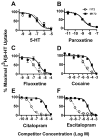Natural and engineered coding variation in antidepressant-sensitive serotonin transporters
- PMID: 21893166
- PMCID: PMC3850749
- DOI: 10.1016/j.neuroscience.2011.08.056
Natural and engineered coding variation in antidepressant-sensitive serotonin transporters
Abstract
The presynaptic serotonin (5-HT) transporter (SERT) is a key regulator of 5-HT signaling and is a major target for antidepressant medications and psychostimulants. In recent years, studies of natural and engineered genetic variation in SERT have provided new opportunities to understand structural dimensions of drug interactions and regulation of the transporter, to explore 5-HT contributions to antidepressant action, and to assess the impact of SERT-mediated 5-HT contributions to neuropsychiatric disorders. Here we review three examples from our recent studies where genetic changes in SERT, identified or engineered, have led to new models, findings, and theories that cast light on new dimensions of 5-HT action in the CNS and periphery. First, we review our work to identify specific residues through which SERT recognizes antagonists, and the conversion of this knowledge to the creation of mice lacking high-affinity antidepressant and cocaine sensitivity. Second, we discuss our studies of functional coding variation in SERT that exists in commonly used strains of inbred mice, and how this variation is beginning to reveal novel 5-HT-associated phenotypes. Third, we review our identification and functional characterization of multiple, hyperactive SERT coding variants in subjects with autism. Each of these activities has driven the development of new model systems that can be further exploited to understand the contribution of 5-HT signaling to risk for neuropsychiatric disorders and their treatment.
Copyright © 2011. Published by Elsevier Ltd.
Figures




Similar articles
-
Transgenic elimination of high-affinity antidepressant and cocaine sensitivity in the presynaptic serotonin transporter.Proc Natl Acad Sci U S A. 2011 Mar 1;108(9):3785-90. doi: 10.1073/pnas.1011920108. Epub 2011 Jan 31. Proc Natl Acad Sci U S A. 2011. PMID: 21282638 Free PMC article.
-
The Gain-of-Function Integrin β3 Pro33 Variant Alters the Serotonin System in the Mouse Brain.J Neurosci. 2017 Nov 15;37(46):11271-11284. doi: 10.1523/JNEUROSCI.1482-17.2017. Epub 2017 Oct 16. J Neurosci. 2017. PMID: 29038237 Free PMC article.
-
Essential Contributions of Serotonin Transporter Inhibition to the Acute and Chronic Actions of Fluoxetine and Citalopram in the SERT Met172 Mouse.Neuropsychopharmacology. 2016 Jun;41(7):1733-41. doi: 10.1038/npp.2015.335. Epub 2015 Oct 30. Neuropsychopharmacology. 2016. PMID: 26514584 Free PMC article.
-
Serotonin Transporter Ala276 Mouse: Novel Model to Assess the Neurochemical and Behavioral Impact of Thr276 Phosphorylation In Vivo.Neurochem Res. 2022 Jan;47(1):37-60. doi: 10.1007/s11064-021-03299-w. Epub 2021 Apr 8. Neurochem Res. 2022. PMID: 33830406 Free PMC article. Review.
-
Serotonin transport in the 21st century.J Gen Physiol. 2019 Nov 4;151(11):1248-1264. doi: 10.1085/jgp.201812066. Epub 2019 Sep 30. J Gen Physiol. 2019. PMID: 31570504 Free PMC article. Review.
Cited by
-
Drosophila melanogaster as a genetic model system to study neurotransmitter transporters.Neurochem Int. 2014 Jul;73:71-88. doi: 10.1016/j.neuint.2014.03.015. Epub 2014 Apr 3. Neurochem Int. 2014. PMID: 24704795 Free PMC article. Review.
-
Cocaine modulates mammalian circadian clock timing by decreasing serotonin transport in the SCN.Neuroscience. 2014 Sep 5;275:184-93. doi: 10.1016/j.neuroscience.2014.06.012. Epub 2014 Jun 17. Neuroscience. 2014. PMID: 24950119 Free PMC article.
-
Rare Opportunities for Insights Into Serotonergic Contributions to Brain and Bowel Disorders: Studies of the SERT Ala56 Mouse.Front Cell Neurosci. 2021 Jun 3;15:677563. doi: 10.3389/fncel.2021.677563. eCollection 2021. Front Cell Neurosci. 2021. PMID: 34149362 Free PMC article.
-
Evaluation of heritable determinants of blood and brain serotonin homeostasis using recombinant inbred mice.Genes Brain Behav. 2014 Mar;13(3):247-60. doi: 10.1111/gbb.12092. Epub 2013 Oct 31. Genes Brain Behav. 2014. PMID: 24102824 Free PMC article.
-
Serotonin and Serotonin Transporters in the Adrenal Medulla: A Potential Hub for Modulation of the Sympathetic Stress Response.ACS Chem Neurosci. 2017 May 17;8(5):943-954. doi: 10.1021/acschemneuro.7b00026. Epub 2017 Apr 13. ACS Chem Neurosci. 2017. PMID: 28406285 Free PMC article. Review.
References
-
- Abumaria N, Rygula R, Hiemke C, Fuchs E, Havemann-Reinecke U, Rüther E, Flügge G. Effect of chronic citalopram on serotonin-related and stress-regulated genes in the dorsal raphe nucleus of the rat. Eur Neuropsychopharmacol. 2007;17:417–429. - PubMed
-
- Adkins EM, Barker EL, Blakely RD. Interactions of tryptamine derivatives with serotonin transporter species variants implicate transmembrane domain I in substrate recognition. Mol Pharmacol. 2001;59:514–523. - PubMed
-
- Anderson GM. Genetics of childhood disorders: XLV. Autism, part 4: serotonin in autism. J Am Acad Child Adolesc Psychiatry. 2002;41:1513–1516. - PubMed
-
- Barkan T, Gurwitz D, Levy G, Weizman A, Rehavi M. Biochemical and pharmacological characterization of the serotonin transporter in human peripheral blood lymphocytes. Eur Neuropsychopharmacol. 2004;14:237–243. - PubMed
-
- Barker EL, Perlman MA, Adkins EM, Houlihan WJ, Pristupa ZB, Niznik HB, Blakely RD. High affinity recognition of serotonin transporter antagonists defined by species-scanning mutagenesis. An aromatic residue in transmembrane domain I dictates species-selective recognition of citalopram and mazindol. J Biol Chem. 1998;273:19459–19468. - PubMed
Publication types
MeSH terms
Substances
Grants and funding
LinkOut - more resources
Full Text Sources
Miscellaneous

